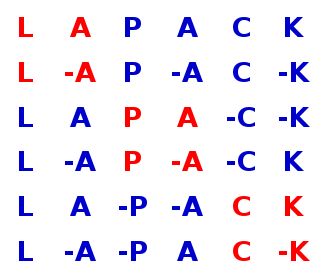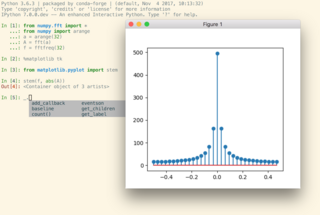
Parallel computing is a type of computation in which many calculations or processes are carried out simultaneously. Large problems can often be divided into smaller ones, which can then be solved at the same time. There are several different forms of parallel computing: bit-level, instruction-level, data, and task parallelism. Parallelism has long been employed in high-performance computing, but has gained broader interest due to the physical constraints preventing frequency scaling. As power consumption by computers has become a concern in recent years, parallel computing has become the dominant paradigm in computer architecture, mainly in the form of multi-core processors.
Message Passing Interface (MPI) is a standardized and portable message-passing standard designed to function on parallel computing architectures. The MPI standard defines the syntax and semantics of library routines that are useful to a wide range of users writing portable message-passing programs in C, C++, and Fortran. There are several open-source MPI implementations, which fostered the development of a parallel software industry, and encouraged development of portable and scalable large-scale parallel applications.

OpenMP is an application programming interface (API) that supports multi-platform shared-memory multiprocessing programming in C, C++, and Fortran, on many platforms, instruction-set architectures and operating systems, including Solaris, AIX, FreeBSD, HP-UX, Linux, macOS, and Windows. It consists of a set of compiler directives, library routines, and environment variables that influence run-time behavior.

Jack Joseph Dongarra is an American computer scientist and mathematician. He is the American University Distinguished Professor of Computer Science in the Electrical Engineering and Computer Science Department at the University of Tennessee. He holds the position of a Distinguished Research Staff member in the Computer Science and Mathematics Division at Oak Ridge National Laboratory, Turing Fellowship in the School of Mathematics at the University of Manchester, and is an adjunct professor and teacher in the Computer Science Department at Rice University. He served as a faculty fellow at the Texas A&M University Institute for Advanced Study (2014–2018). Dongarra is the founding director of the Innovative Computing Laboratory at the University of Tennessee. He was the recipient of the Turing Award in 2021.

LAPACK is a standard software library for numerical linear algebra. It provides routines for solving systems of linear equations and linear least squares, eigenvalue problems, and singular value decomposition. It also includes routines to implement the associated matrix factorizations such as LU, QR, Cholesky and Schur decomposition. LAPACK was originally written in FORTRAN 77, but moved to Fortran 90 in version 3.2 (2008). The routines handle both real and complex matrices in both single and double precision. LAPACK relies on an underlying BLAS implementation to provide efficient and portable computational building blocks for its routines.
In computing, single program, multiple data (SPMD) is a term that has been used to refer to computational models for exploiting parallelism where-by multiple processors cooperate in the execution of a program in order to obtain results faster.
In computing, a parallel programming model is an abstraction of parallel computer architecture, with which it is convenient to express algorithms and their composition in programs. The value of a programming model can be judged on its generality: how well a range of different problems can be expressed for a variety of different architectures, and its performance: how efficiently the compiled programs can execute. The implementation of a parallel programming model can take the form of a library invoked from a sequential language, as an extension to an existing language, or as an entirely new language.
Concurrent computing is a form of computing in which several computations are executed concurrently—during overlapping time periods—instead of sequentially—with one completing before the next starts.
The ScaLAPACK library includes a subset of LAPACK routines redesigned for distributed memory MIMD parallel computers. It is currently written in a Single-Program-Multiple-Data style using explicit message passing for interprocessor communication. It assumes matrices are laid out in a two-dimensional block cyclic decomposition.

Chapel, the Cascade High Productivity Language, is a parallel programming language that was developed by Cray, and later by Hewlett Packard Enterprise which acquired Cray. It was being developed as part of the Cray Cascade project, a participant in DARPA's High Productivity Computing Systems (HPCS) program, which had the goal of increasing supercomputer productivity by 2010. It is being developed as an open source project, under version 2 of the Apache license.
Trilinos is a collection of open-source software libraries, called packages, intended to be used as building blocks for the development of scientific applications. The word "Trilinos" is Greek and conveys the idea of "a string of pearls", suggesting a number of software packages linked together by a common infrastructure. Trilinos was developed at Sandia National Laboratories from a core group of existing algorithms and utilizes the functionality of software interfaces such as BLAS, LAPACK, and MPI. In 2004, Trilinos received an R&D100 Award.

Data parallelism is parallelization across multiple processors in parallel computing environments. It focuses on distributing the data across different nodes, which operate on the data in parallel. It can be applied on regular data structures like arrays and matrices by working on each element in parallel. It contrasts to task parallelism as another form of parallelism.
Task parallelism is a form of parallelization of computer code across multiple processors in parallel computing environments. Task parallelism focuses on distributing tasks—concurrently performed by processes or threads—across different processors. In contrast to data parallelism which involves running the same task on different components of data, task parallelism is distinguished by running many different tasks at the same time on the same data. A common type of task parallelism is pipelining, which consists of moving a single set of data through a series of separate tasks where each task can execute independently of the others.

IPython is a command shell for interactive computing in multiple programming languages, originally developed for the Python programming language, that offers introspection, rich media, shell syntax, tab completion, and history. IPython provides the following features:
Intel oneAPI Math Kernel Library is a library of optimized math routines for science, engineering, and financial applications. Core math functions include BLAS, LAPACK, ScaLAPACK, sparse solvers, fast Fourier transforms, and vector math.
In computing, algorithmic skeletons, or parallelism patterns, are a high-level parallel programming model for parallel and distributed computing.
For several years parallel hardware was only available for distributed computing but recently it is becoming available for the low end computers as well. Hence it has become inevitable for software programmers to start writing parallel applications. It is quite natural for programmers to think sequentially and hence they are less acquainted with writing multi-threaded or parallel processing applications. Parallel programming requires handling various issues such as synchronization and deadlock avoidance. Programmers require added expertise for writing such applications apart from their expertise in the application domain. Hence programmers prefer to write sequential code and most of the popular programming languages support it. This allows them to concentrate more on the application. Therefore, there is a need to convert such sequential applications to parallel applications with the help of automated tools. The need is also non-trivial because large amount of legacy code written over the past few decades needs to be reused and parallelized.







